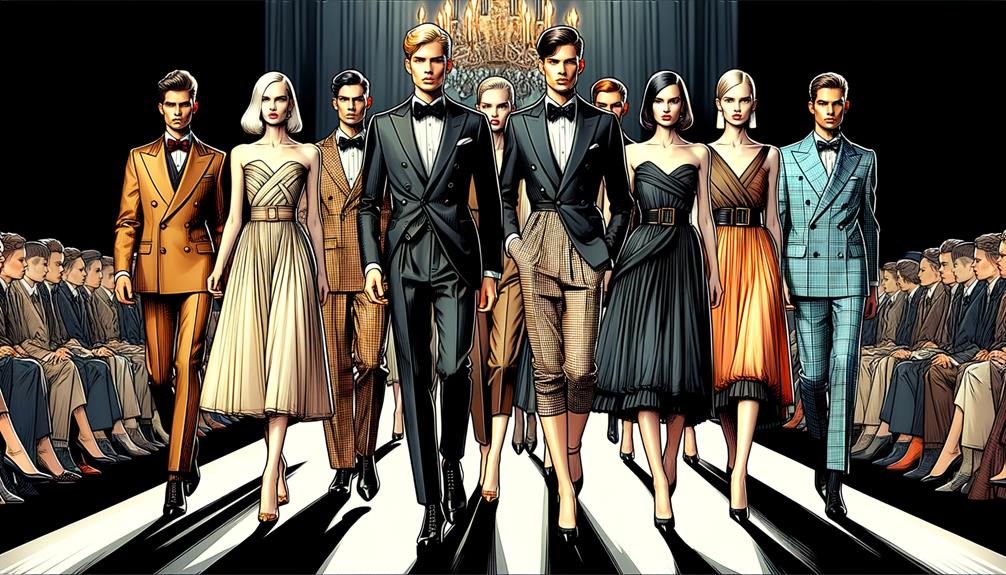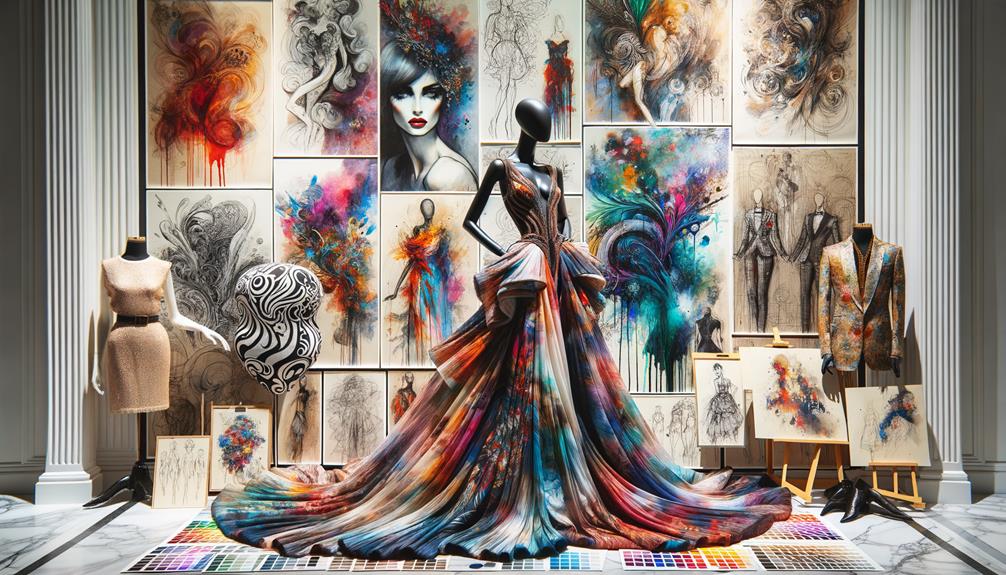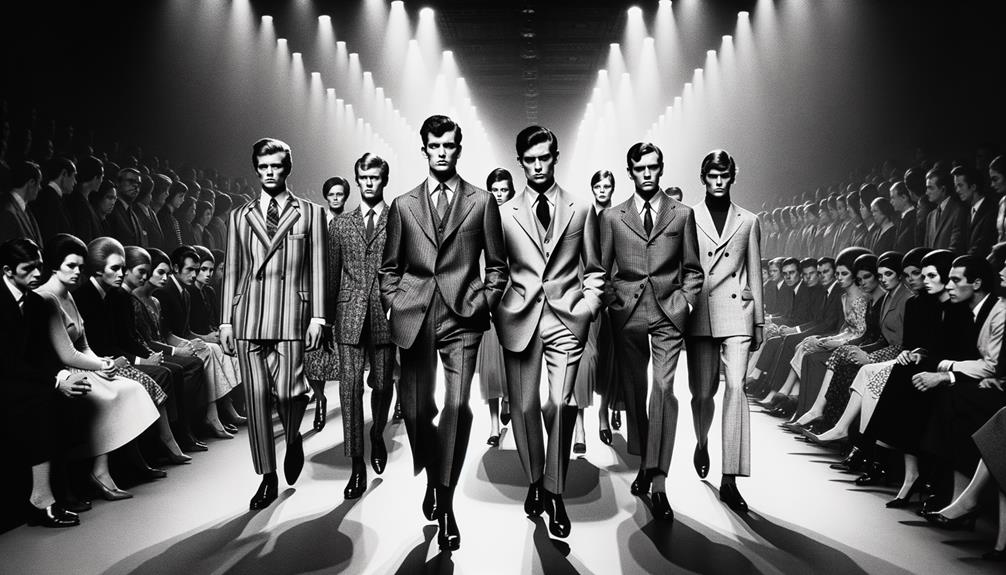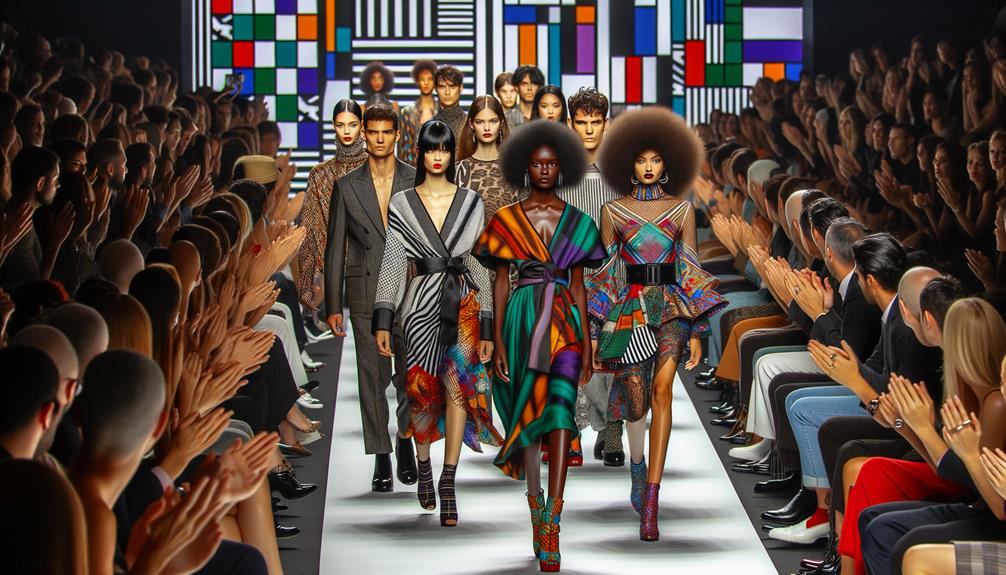Yves Saint Laurent didn't just design clothes, he changed the face of fashion. When he joined Dior in 1955, he transformed haute couture with his bold Trapeze line. His iconic Le Smoking tuxedo and Mondrian Collection seamlessly merged art and fashion, making bold statements. He challenged traditional gender norms with androgynous styles, empowering women to break free from conventions. His Rive Gauche boutique made high fashion accessible, and his commitment to diversity brought new representation to the runway. It's remarkable how his vision continues to inspire today's designers. There's so much more to his groundbreaking journey and lasting legacy.
Early Career
When I witnessed Yves Saint Laurent join Christian Dior in 1955, his exceptional talent was immediately apparent. As a young French designer, he revolutionized haute couture with his innovative vision. His 1958 debut Trapeze line marked a significant turning point in fashion, introducing lighter, fluid silhouettes that liberated women from restrictive styles. This collection wasn't just about fabric and design; it challenged societal norms and redefined femininity.
In 1966, Saint Laurent introduced the Le Smoking tuxedo suit, a bold statement of rebellion and androgyny. This wasn't just a new outfit; it gave women the same sartorial choices as men, symbolizing a break from tradition and embracing modernity. Catherine Deneuve, among other influential women, embraced his designs, further amplifying his impact on the fashion world.
Yves Saint Laurent's early career was a masterclass in understanding and shaping societal trends. His work at Dior laid the groundwork for a new era in fashion, one that celebrated innovation and pushing boundaries.
Iconic Designs

When I think about Yves Saint Laurent's most iconic designs, three creations immediately come to mind: the groundbreaking Le Smoking tuxedo, the vibrant Mondrian collection dresses, and the adventurous safari jacket. These pieces didn't just define fashion trends; they challenged societal norms and introduced new ways of seeing and dressing. Saint Laurent's genius lay in his ability to merge artistry with bold statements, creating a lasting impact on the fashion world.
Le Smoking Tuxedo
Yves Saint Laurent's introduction of the Le Smoking tuxedo in 1966 was a bold move that redefined women's fashion and challenged societal norms. When Saint Laurent presented the sleek, fitted suit, he did more than just showcase a new outfit – he reimagined the boundaries of women's fashion. This radical departure from traditional feminine attire symbolized rebellion and androgyny, making a powerful statement that challenged the entrenched gender norms of the time.
The Le Smoking tuxedo was about more than just style; it was about empowerment. Saint Laurent believed women deserved practical yet elegant wardrobe options, and the tuxedo served as a timeless, versatile ensemble. It offered women an alternative to dresses and skirts, giving them a powerful sartorial choice.
Catherine Deneuve, among other early adopters, helped solidify the tuxedo's status as a fashion staple. Whenever I see images of Deneuve in Le Smoking, I'm struck by the palpable sense of empowerment that the suit radiates. It's not just a piece of clothing; it's a declaration of autonomy and strength.
In essence, Le Smoking revolutionized the modern woman's wardrobe, embodying Saint Laurent's vision of liberation through fashion.
Mondrian Collection Dresses
Yves Saint Laurent's Mondrian Collection dresses in 1965 revolutionized fashion by merging art and haute couture through bold primary colors and striking geometric shapes. These iconic dresses weren't just garments; they were statements that seamlessly merged the worlds of abstract art and fashion.
Observing the Mondrian Collection, it's clear that Saint Laurent pioneered a new approach to fashion by incorporating Piet Mondrian's abstract art into his designs. His use of geometric shapes and primary colors created a visual dialogue between the canvas and the runway. The significance of these dresses lies in their bold simplicity and the innovative approach Saint Laurent took to integrate art into fashion.
Reflecting on the impact of these designs, several key points stand out:
- Art and Fashion Unite: The Mondrian Collection broke barriers, blending two distinct forms into a unified expression.
- Haute Couture Innovation: Saint Laurent's designs showcased an avant-garde approach, setting new standards in high fashion.
- Timeless Inspiration: These dresses continue to influence contemporary fashion, underscoring their lasting relevance.
- Visual Impact: The use of bold, primary colors and geometric shapes created an unmistakable and memorable design language.
Saint Laurent's Mondrian Collection remains a testament to his visionary genius.
Safari Jacket Trend
There's something captivating about Yves Saint Laurent's safari jacket, which seamlessly blends practicality with high fashion. Introduced in 1968, this iconic design was inspired by Saint Laurent's love for travel and adventure. The safari jacket's multiple pockets and belted waist weren't just functional; they showcased the perfect blend of utility and elegance.
When I think about the impact of this innovative garment, it's clear that Saint Laurent wasn't just designing a jacket – he was redefining casual sophistication. The safari jacket broke free from traditional fashion norms, offering a versatile piece that could be worn by both men and women. Its appeal wasn't limited to the runways; celebrities and fashion enthusiasts quickly fell in love with it, cementing its status as a timeless wardrobe staple.
Reflecting on its history, I can see how the safari jacket embodies the spirit of adventure and exploration. It's a testament to Saint Laurent's genius that something so utilitarian could become so iconic. This trend didn't just influence fashion; it changed how we perceive practicality and elegance, proving that the two can coexist seamlessly. Yves Saint Laurent's safari jacket remains an enduring symbol of his innovative approach to fashion.
Art and Fashion

Yves Saint Laurent's groundbreaking integration of art into fashion revolutionized the runway and redefined wearable art. His 1965 Mondrian collection, featuring bold, geometric patterns inspired by the Dutch painter, showcases his pioneering fusion of art and fashion. This collection wasn't just aesthetically pleasing; it made a bold statement about the intersection of art and fashion.
Saint Laurent's art integration didn't stop there. His runway shows frequently featured art-inspired designs, drawing from the works of Van Gogh and Warhol. By doing so, he blurred the lines between gallery and catwalk, creating a new paradigm where fashion could be seen as high art. His influence extended far beyond his own collections, setting a trend that encouraged future designers to explore similar artistic intersections.
Four key aspects of his art and fashion legacy stand out:
Mondrian Collection: A revolutionary blend of fashion and painting.
Runway Shows: Featuring iconic art-inspired designs.
Gallery Exhibitions: Showcasing fashion as art.
Lasting Influence: Inspiring future designers in the art and fashion intersection.
Saint Laurent's work reminds us that fashion can be a canvas, a space where art lives and breathes.
Gender Norms

When I think about Yves Saint Laurent's impact on gender norms, I'm struck by how he smashed traditional boundaries with his Le Smoking tuxedo suit for women. By blending masculine and feminine elements, he created a fashion influence that was both rebellious and glamorous. This bold move empowered women, offering them a fresh, unisex style that challenged societal expectations and redefined their wardrobe choices.
Breaking Stereotypical Boundaries
Challenging traditional gender norms in fashion, Yves Saint Laurent's introduction of the Le Smoking tuxedo in 1966 revolutionized what women could wear. This bold move wasn't just about fashion; it was a powerful statement against societal expectations. By blending androgyny and empowerment, Saint Laurent offered women an alternative to gowns and skirts, inviting them to embrace a new kind of elegance.
Catherine Deneuve, one of the first to adopt the Le Smoking tuxedo suit, embodied this shift. Her glamorous yet assertive presence in YSL's designs demonstrated how women could break free from stereotypes and claim their space in traditionally male-dominated attire. The Le Smoking tuxedo didn't just challenge gender norms – it shattered them.
Reflecting on this, I see how the modern women's wardrobe owes a debt to Saint Laurent's vision. He didn't just design clothes; he crafted symbols of freedom and self-expression.
Four ways Saint Laurent's Le Smoking tuxedo made a difference:
Rebellion: It defied conventional gender norms.
Empowerment: It gave women a sense of authority.
Androgyny: It blurred the lines between male and female fashion.
Modernization: It transformed the contemporary women's wardrobe.
Saint Laurent's legacy continues to inspire, proving that breaking stereotypes can indeed rewrite history.
Androgynous Fashion Influence
In re-examining the impact of androgynous fashion, it's clear that Yves Saint Laurent's designs blurred traditional gender lines and redefined how society perceives clothing and identity. When Saint Laurent introduced the Le Smoking tuxedo suit for women in 1966, it was more than a bold fashion statement – it was a challenge to rigid gender norms. His androgynous designs offered women a new sense of empowerment, allowing them to adopt traditionally masculine attire without sacrificing their femininity.
Saint Laurent focused on providing women with functional wardrobe options, blending the lines between masculine and feminine styles. Early adopters like Catherine Deneuve embodied this new aesthetic, capturing the spirit of liberation and glamour. His work symbolized a shift in societal expectations, making it acceptable – even celebrated – for women to wear what was once considered exclusively male.
The influence of YSL's androgynous designs extends far beyond the 1960s, paving the way for modern interpretations of gender fluidity in fashion. Today, his vision continues to challenge and inspire the industry, pushing the boundaries of what clothing can signify about identity and self-expression. Saint Laurent's heritage is a testament to the power of fashion in shaping cultural norms and individual empowerment.
Empowering Unisex Styles
Saint Laurent's revolutionary designs did more than just blur gender lines – they gave individuals the freedom to express themselves authentically through unisex styles. When Yves Saint Laurent introduced the Le Smoking tuxedo suit for women in 1966, it was a bold statement against rigid gender norms, offering modern women the power to embrace androgyny and rebellion.
The impact of Le Smoking can be broken down into four key elements:
- Empowerment: Women like Catherine Deneuve adopted the Le Smoking suit, marking a shift towards gender equality in fashion.
- Practicality: Saint Laurent aimed to provide women with wardrobes that were both stylish and functional, moving away from traditional, restrictive attire.
- Symbolism: The tuxedo suit became a symbol of liberation, giving women the confidence to wear traditionally male clothing.
- Industry Impact: YSL's unisex designs helped pave the way for a more inclusive and diverse fashion industry, setting a precedent for future designers.
Reflecting on these points, it's clear that Saint Laurent's work went beyond aesthetics. His unisex styles challenged the status quo and inspired countless individuals to redefine their identities, fostering a more inclusive and innovative world.
Championing Diversity

Breaking racial barriers in the fashion industry, Yves Saint Laurent was a pioneer in featuring women of color on the runway, showcasing his unwavering commitment to diversity. Looking at his work with muses like Iman and Rebecca Ayoko, I'm reminded of how groundbreaking this was. It wasn't just about putting women of color on the catwalk; it was about celebrating their beauty and talent in an industry that often marginalized them.
Saint Laurent's influence extended beyond the catwalk. He advocated for diversity on the pages of Vogue, leading to more women of color gracing its covers. This marked a significant shift in an era when representation was sorely lacking. It's clear that his vision for inclusivity wasn't a fleeting trend but a genuine effort to reshape the fashion landscape.
Ready-to-Wear Revolution

The ready-to-wear revolution sparked by Yves Saint Laurent's Rive Gauche boutique in 1966 transformed how modern women approached their wardrobes. Saint Laurent bridged the gap between haute couture and everyday wear, making high fashion more accessible. His innovative approach emphasized wardrobe essentials that could be mixed and matched effortlessly.
Rive Gauche boutique was a laboratory for experimentation, redefining the relationship between designer and consumer. Saint Laurent made stylish clothing affordable and practical, shifting the fashion industry in several ways:
- Freedom through Versatility: Saint Laurent's mix-and-match separates gave modern women the freedom to create multiple looks from a few key pieces.
- Accessibility: By integrating haute couture elements into ready-to-wear designs, he made fashion more inclusive.
- Pioneering Spirit: His groundbreaking work at Rive Gauche showcased his ability to think ahead of his time.
- Cultural Shift: By reshaping how women viewed their wardrobes, he influenced the broader cultural landscape.
Rive Gauche remains a testament to Saint Laurent's ingenious legacy, forever altering the fashion industry.
Frequently Asked Questions
Why Was Yves Saint Laurent so Influential?
Why was Yves Saint Laurent so influential? He shattered conventions, merging art and fashion to create a new language. His designs empowered women, celebrated individuality, and made high fashion accessible to all. His vision was truly groundbreaking.
What Is Yves Saint Laurent Best Known For?
Yves Saint Laurent is perhaps most famous for creating the iconic Le Smoking tuxedo suit for women, which challenged traditional gender norms and redefined fashion with its androgynous, rebellious flair. By offering women powerful, glamorous, and functional wardrobe choices, Saint Laurent empowered them to express themselves in new and exciting ways.
Why Was Yves Dropped From Saint Laurent?
When the fashion brand dropped 'Yves' from Saint Laurent, it was an attempt to modernize and appeal to a younger demographic. The goal was to emphasize the iconic YSL logo and create a more streamlined brand image.
Who Is the Creative Designer of Yves Saint Laurent?
Reflecting on the current question, I see that the creative designer of Yves Saint Laurent is Anthony Vaccarello. His innovative vision and modern edge continue to push the boundaries of fashion, staying true to the brand's revolutionary spirit.


